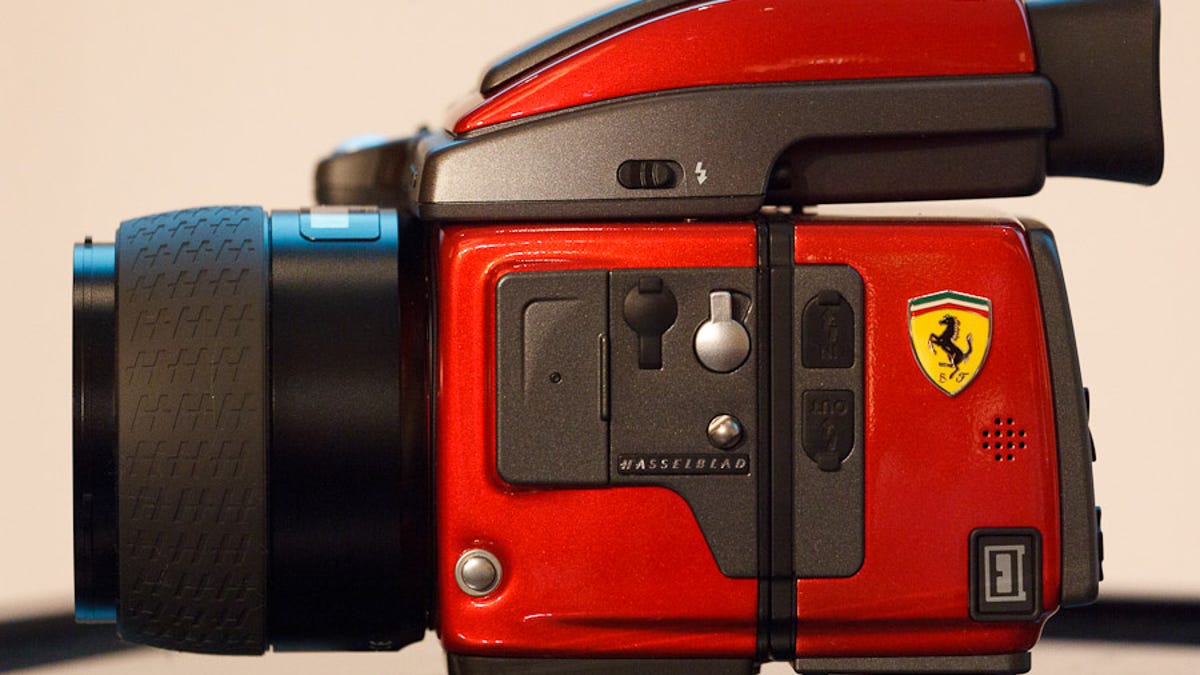Hasselblad plans 200-megapixel camera for 2011
Extended multishot technology will quadruple the H4D-50's resolution starting in the first quarter of 2011. Also: two new Hasselblad lenses that can keep up.
COLOGNE, Germany--For those who find Hasselblad's 60-megapixel H4D-60 camera a little too confining, the company plans to sell a 200-megapixel model in the first quarter of 2011.
The Copenhagen-based medium-format camera maker announced the product today at the Photokina imaging show here. Interestingly, it uses the same camera body as its current H4D-50MS, which will be upgradable, said Peter Stig-Nielsen, director of product development.
However, even in the rarefied air of the medium-format market, where image sensors are very large and very expensive, the 200-megapixel "extended multishot" technology won't appeal to everyone: each shot will take about 30 seconds to capture, restricting the camera to stationary subjects such as cars, watches, and jewelry.
That's because of the design of the Hasselblad multishot-series cameras such as the H4D-50MS. The current model uses tiny piezoelectric motors to shift the sensor a very small amount to combine two shots into one higher-quality image.
"We are now building it into a real product that's going to hit the market in the first quarter of next year," Stig-Nielsen said. "It is going to be an extension of the current H4D-50 multishot."
Most digital cameras capture color with a checkerboard of color filters called a Bayer pattern over image sensor pixels; each pixel captures only red, green, or blue color information. The multishot technology shifts the sensor so the same pixel can capture each of the colors, ridding the camera of the need to mathematically infer the missing values of red, green, and blue.
Hasselblad's new iteration of the technology, called extended multishot, moves the sensor only a half pixel in various directions, which protracts the multishot process from about 20 seconds to 30 seconds. But it quadruples the resolution of a 50-megapixel sensor.
Multishot and extended multishot modes aren't mandatory, of course, a move that would preclude the models from use in fashion photography, one of the biggest markets for this type of camera.
"The cameras we bring out will be able to work in all three modes at the touch of a button," Stig-Nielsen said.
One issue with a 200-megapixel camera is whether lenses can keep up with the tremendous resolving power. If not, they're just capturing blur more precisely. To that end, Hasselblad also announced two new lenses, overhauled designs that improve on earlier models.
First is the HC 50mm-II, an f3.5 model for 2,999 euros (about $4,006). Second is the HC Macro 120-II, an F4 model with a price of 3,420 euros (about $4570). Both are available immediately.
Older lenses will have some trouble keeping up with the 200-megapixel design. "The old models will still work, but they will not give you 100 percent resolution all the way to the corner," Stig-Nielsen said. With the new models, "you will see resolution all the way edge to edge."
Hasselblad underwent tough times, and more are ahead as full-frame SLR cameras from Canon and Nikon encroach on medium-format turf with advantages in cost, flexibility, low-light sensitivity, accessories, and ease of use. And Hasselblad has had trouble with customer service and delivering the cameras it promises.
But things have improved for Hasselblad.
"In the first eight months of the year, we have had a profitable turnaround," said Chairman Larry Hansen. The period has been "very successful for Hasselblad," he said.
Two factors in the company's better fortunes were an improving economy and restructuring that reduced Hasselblad expenses. But the biggest factor was the "the success of the H4D platform," he said.
Hasselblad's H4D is an integrated system that builds the sensor into the camera body like a conventional SLR. In contrast, earlier film and digital medium-format cameras use a removable back that lets photographers upgrade or change the sensor without changing the camera body.
The design shift hurt a Hasselblad competitor, Phase One, which manufactures such digital backs. Consequently, Phase One acquired a controlling interest in Mamiya, a venerable Japanese medium-format camera company, and sells its camera bodies under the Phase One brand name.
In addition, Phase One acquired another digital camera back maker, Leaf, which at Photokina announced a new 80-megapixel medium-format back.
In these markets, brand is still important even if sales are the merest sliver of the overall camera market. To that end, Hasselblad also announced it's building a limited series of 499 H4D cameras that draw on the clout of another boutique brand, Ferrari.
The special series of cameras sport the Ferrari logo and the gleaming red "rosso fuoco" color of new Ferrari sports cars.
Correction at 6:55 a.m PDT: The references to H4D have been fixed. Correction at 2:08 a.m PDT Sept. 30: The relationship between Phase One and Mamiya has been fixed. Phase One acquired a controlling interest in Mamiya..


